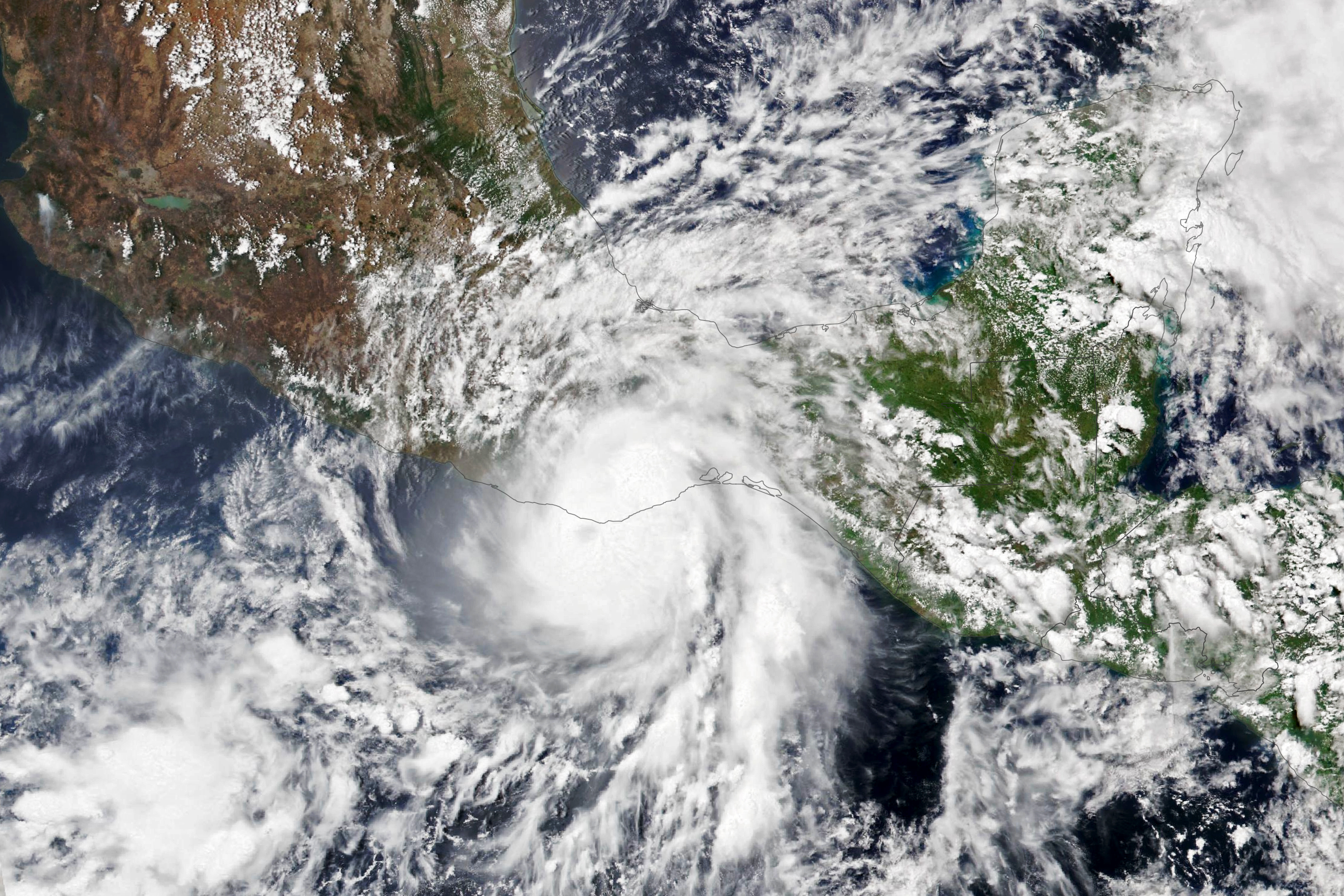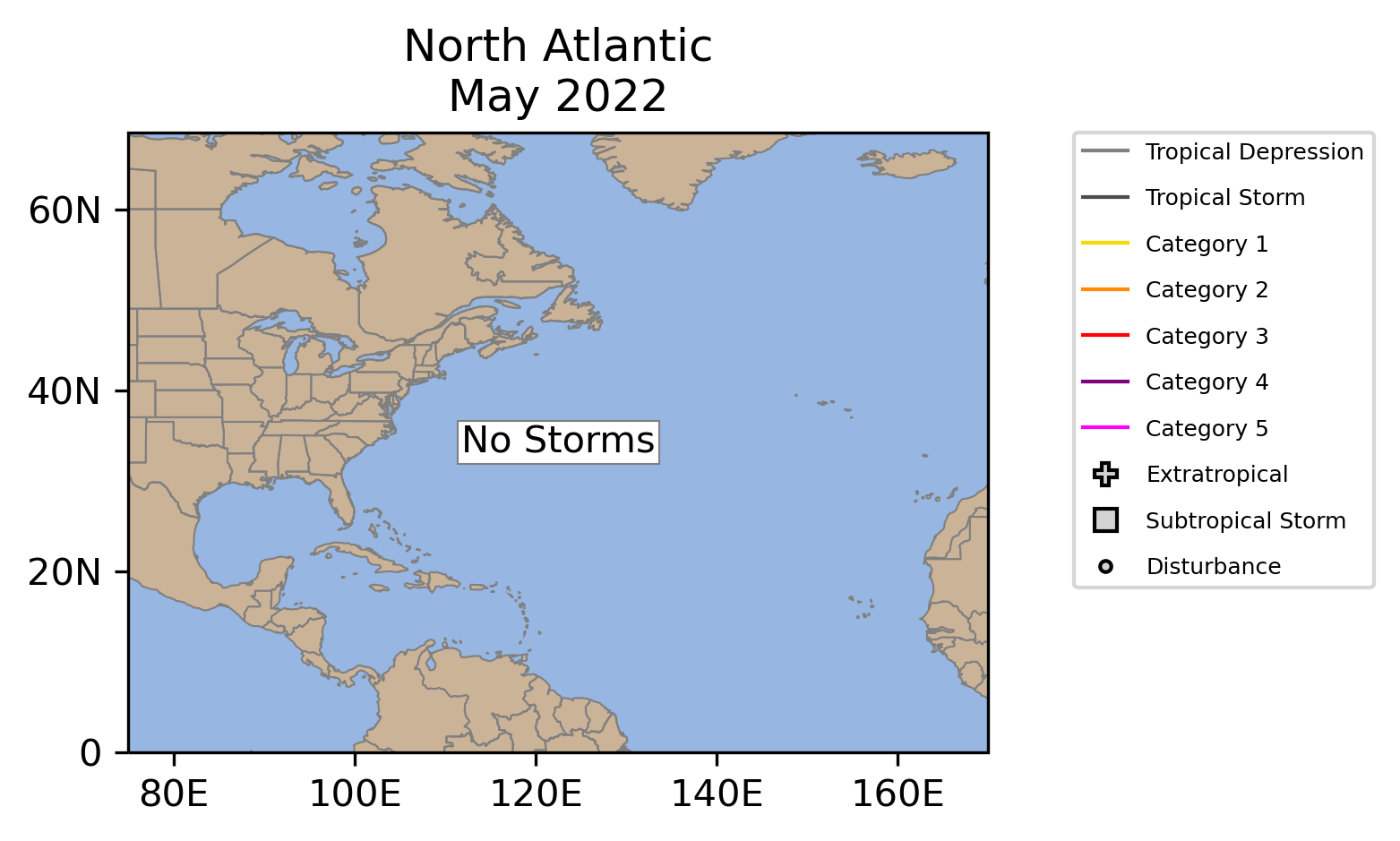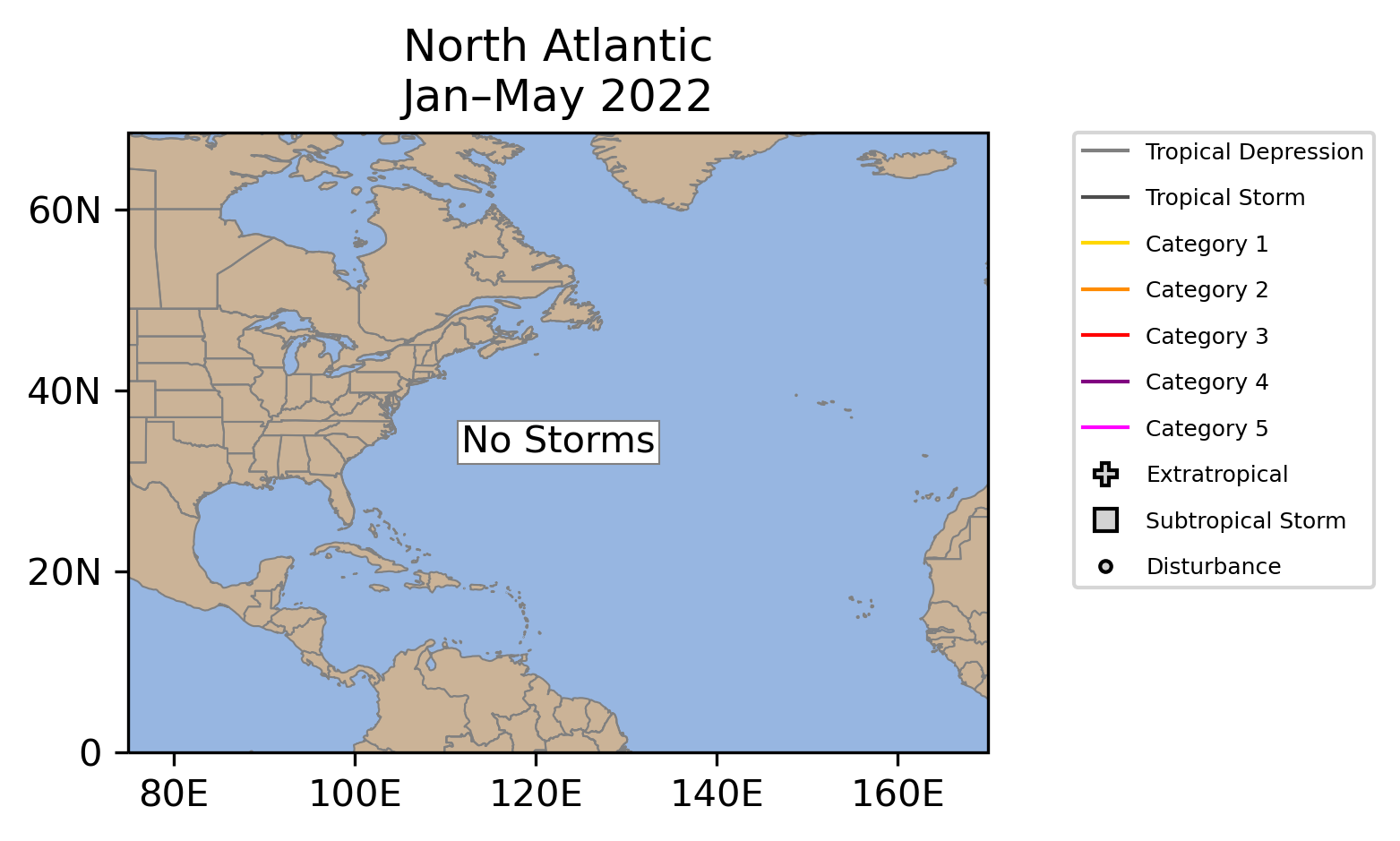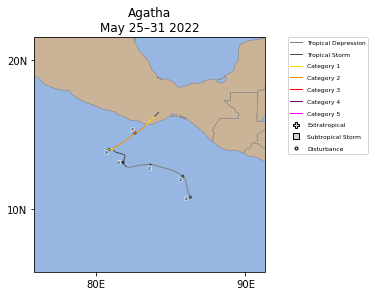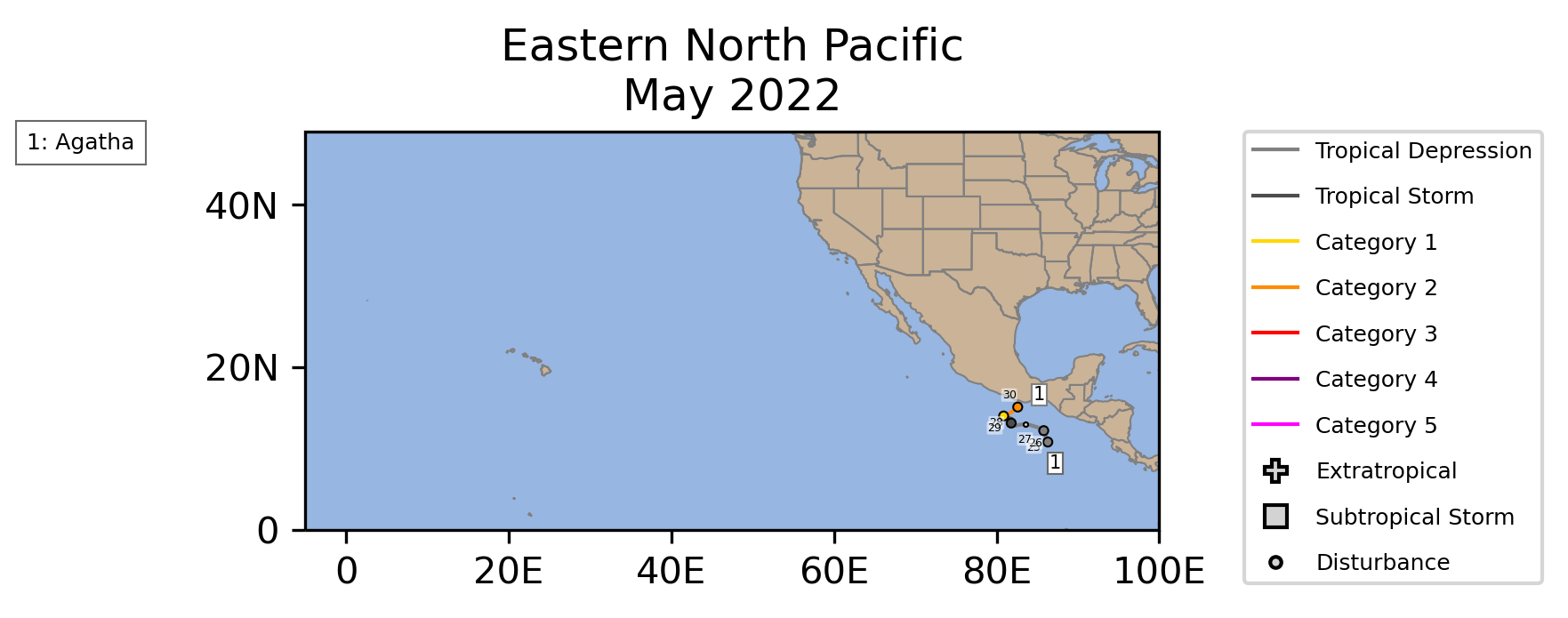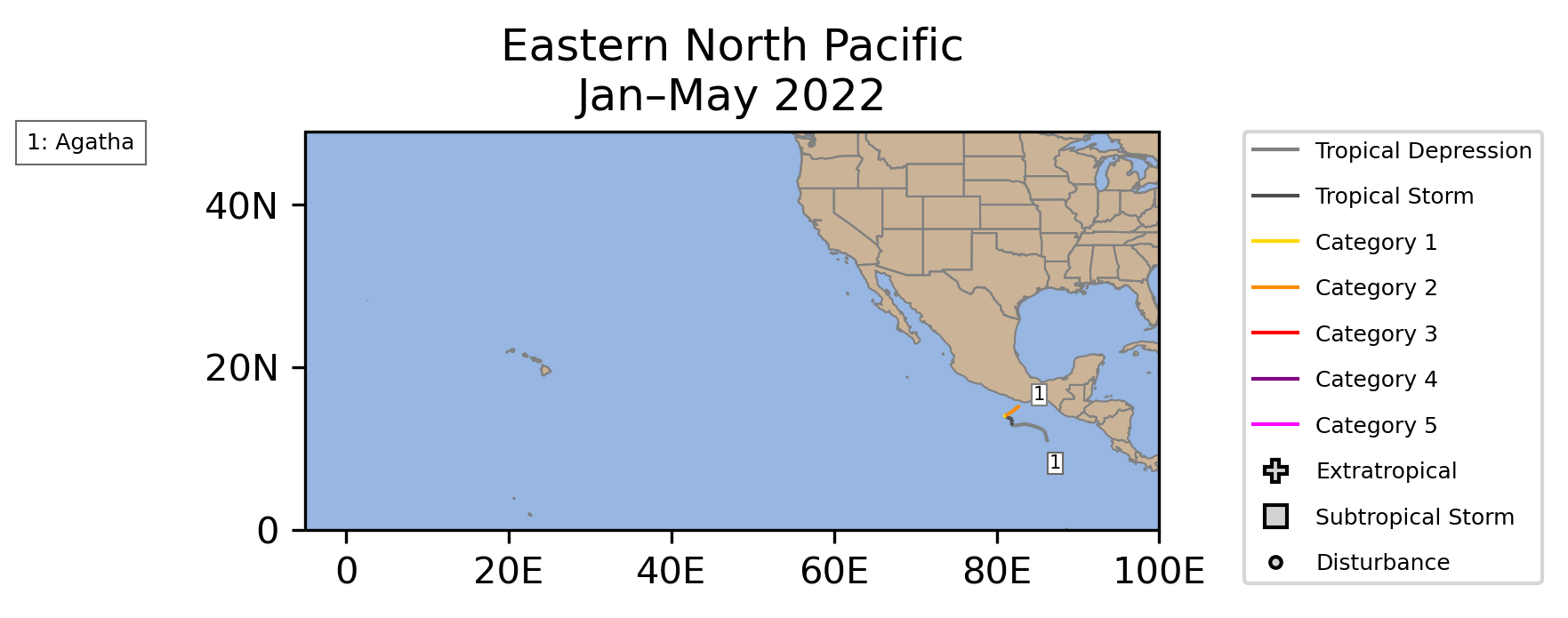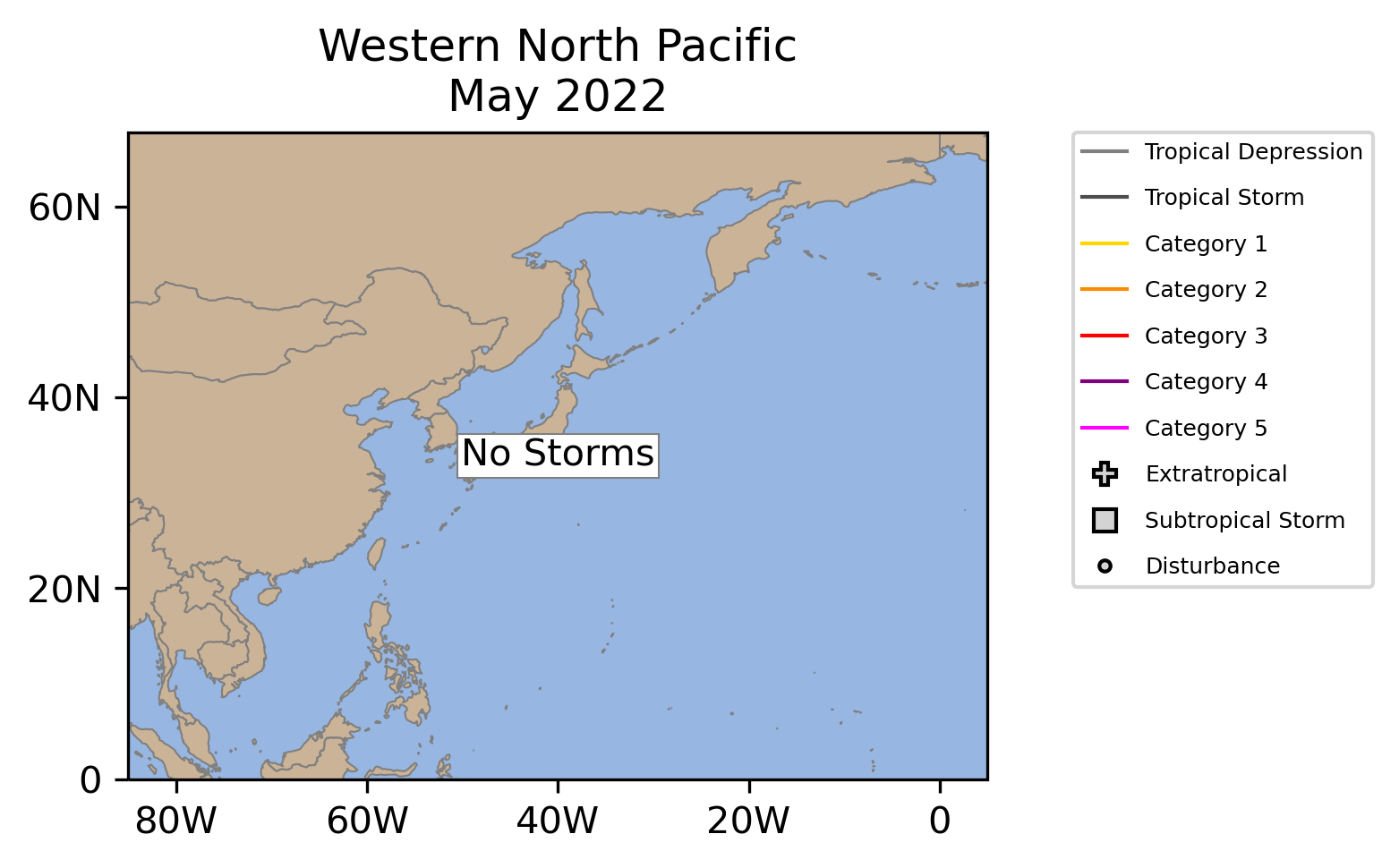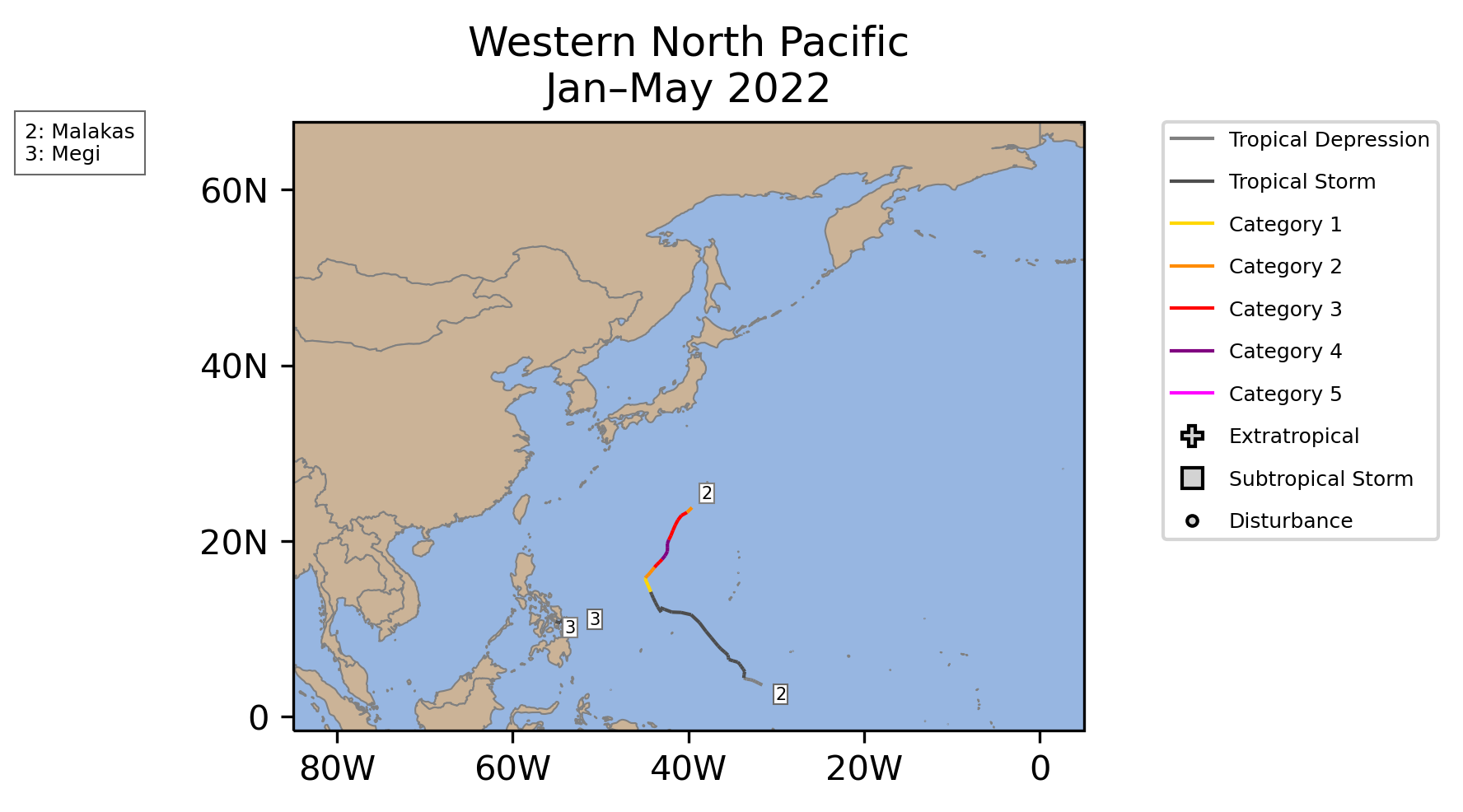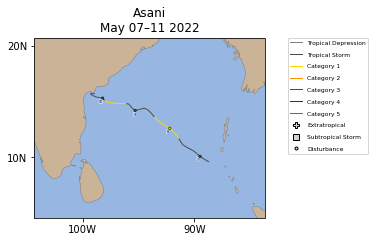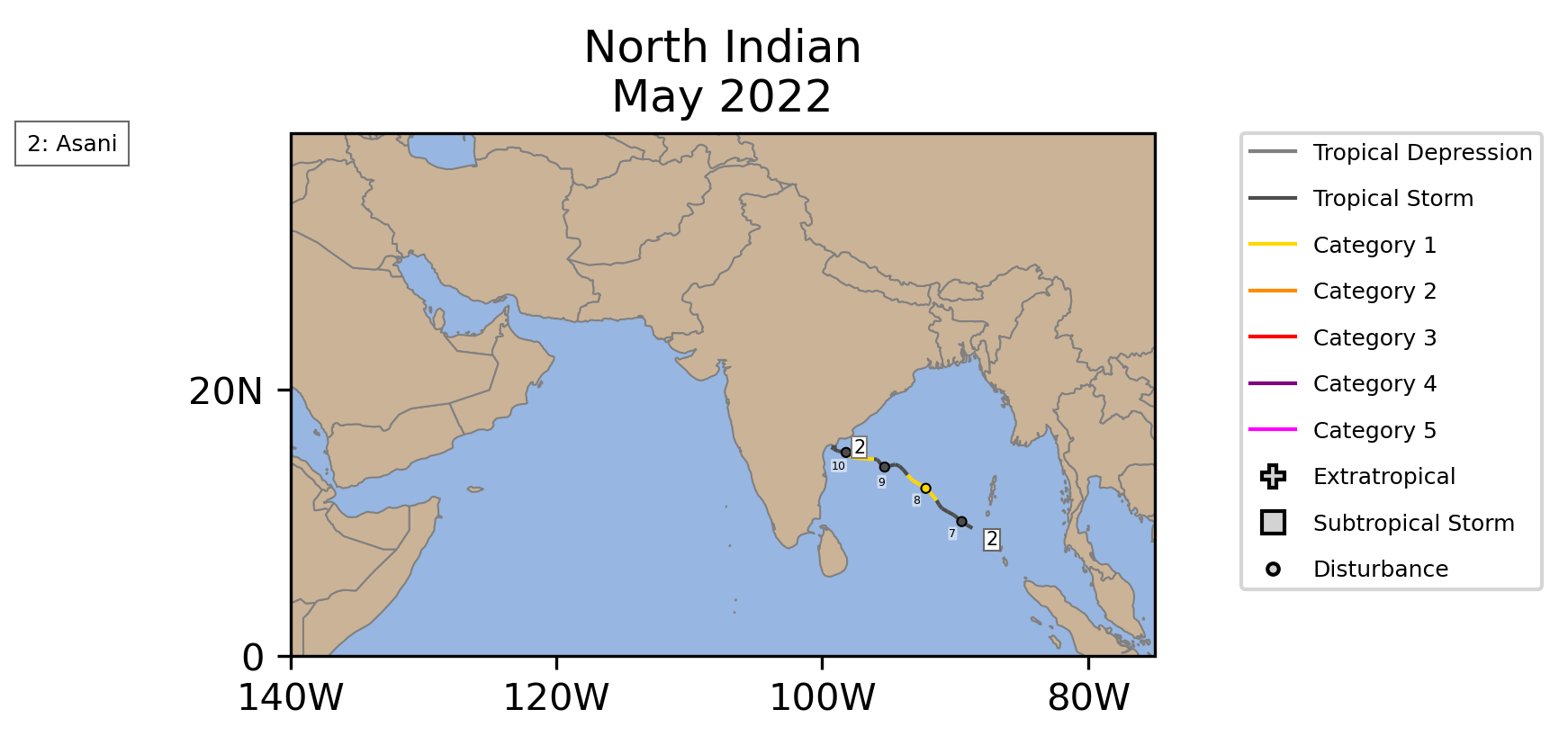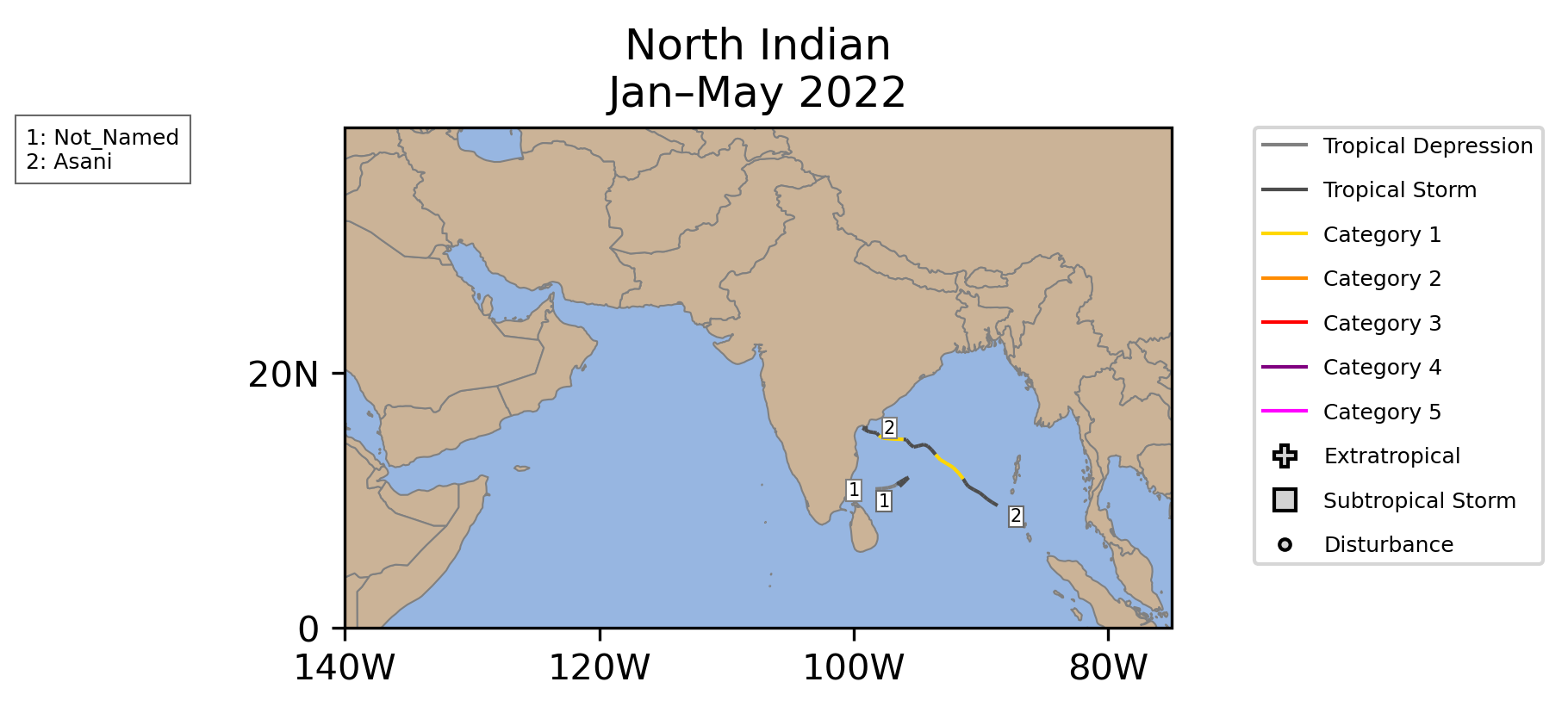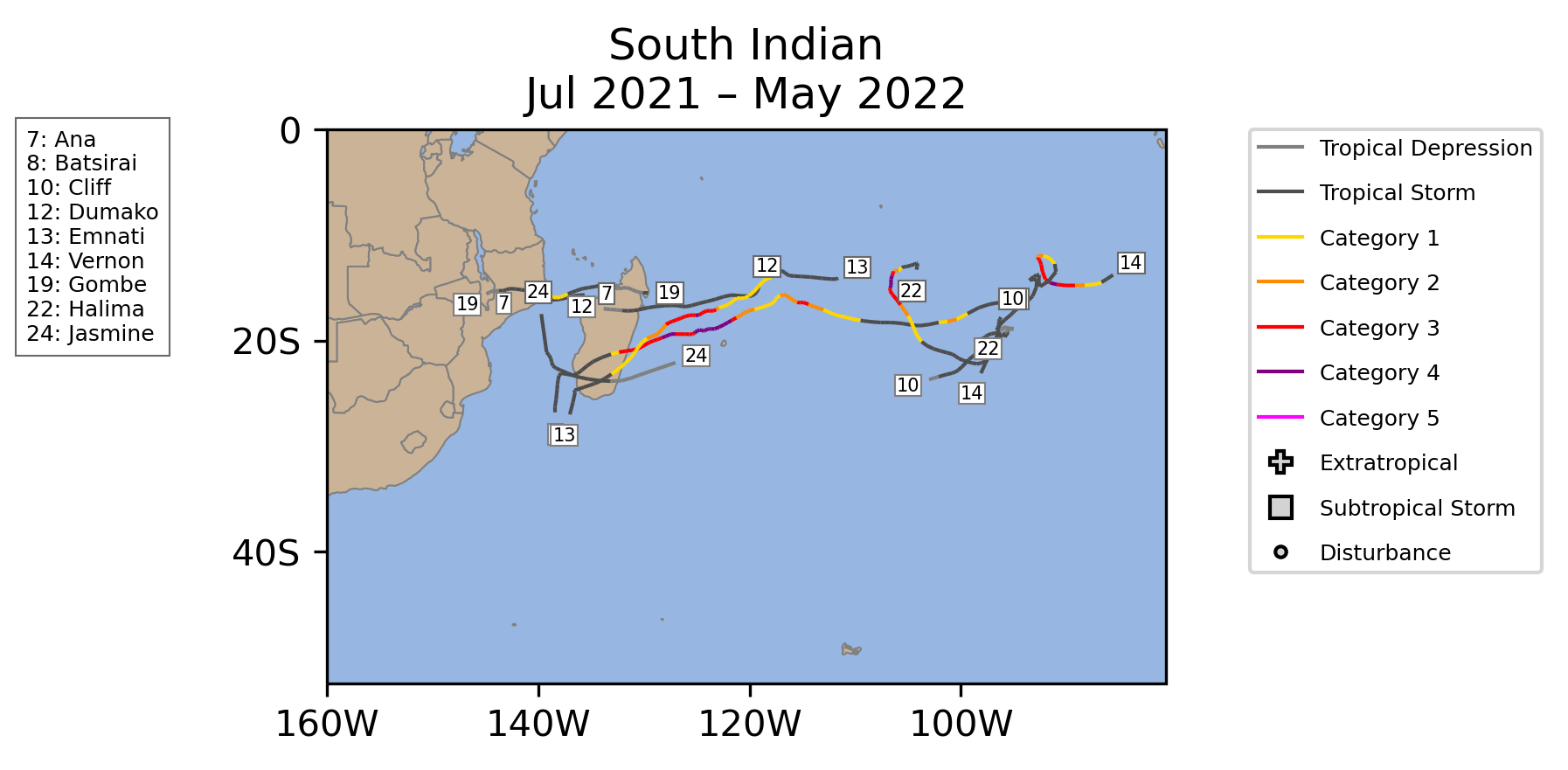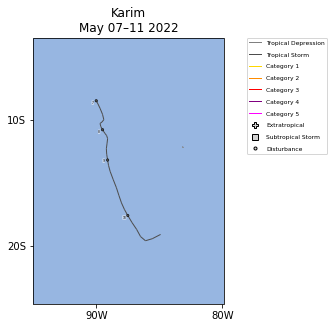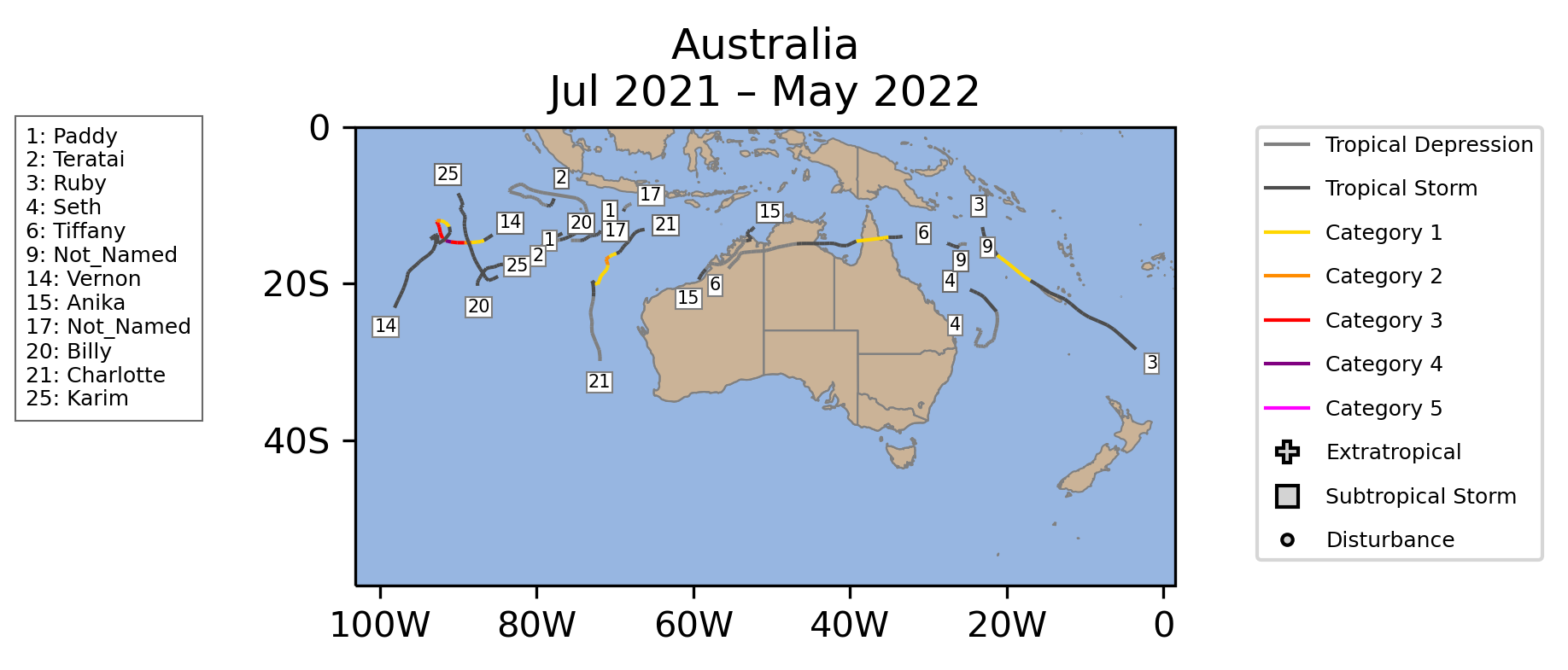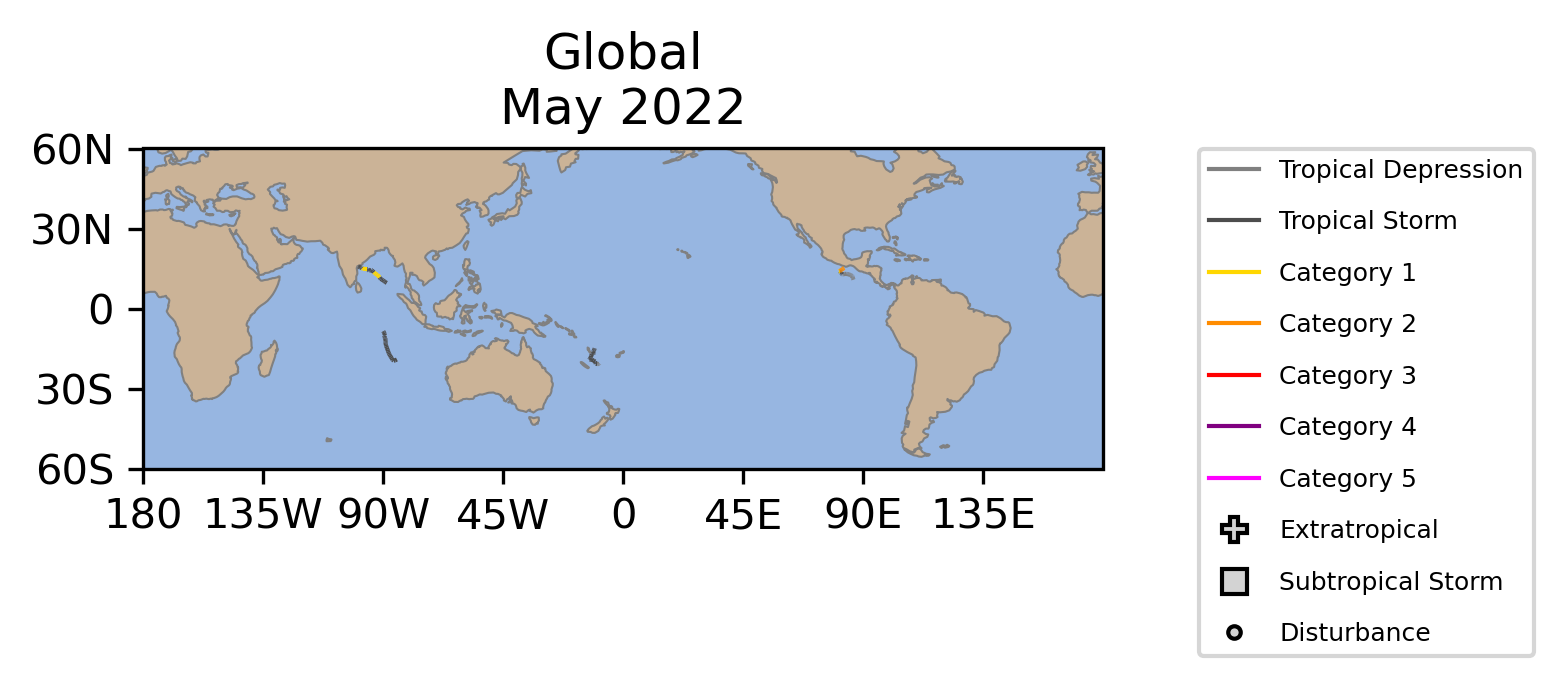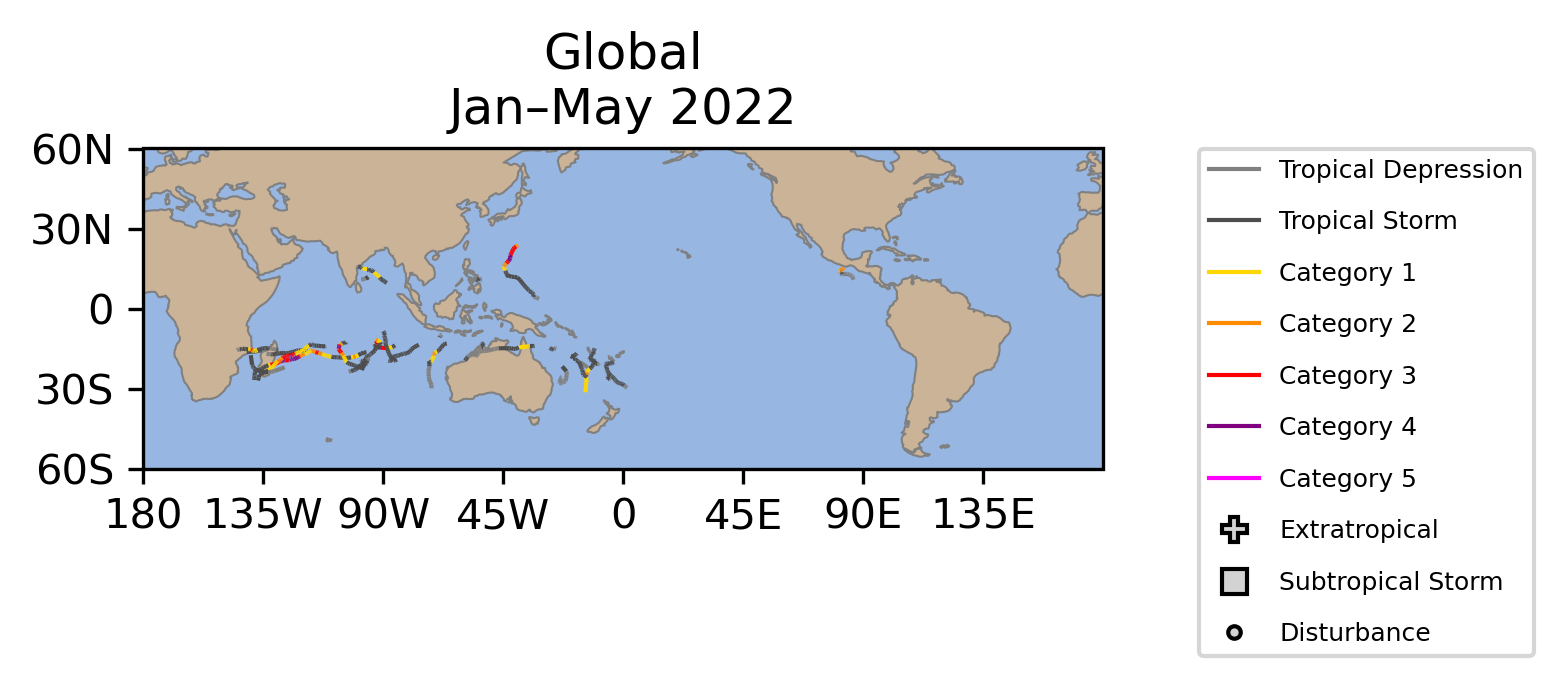Summary
May produced four named storms globally including two that reached tropical cyclone strength (74 mph). Both numbers were near normal. The global accumulated cyclone energy (ACE: an integrated metric of the strength, frequency, and duration of tropical storms) was also near normal even though none of the storms reached major tropical cyclone strength (111 mph). The most impactful storm was Hurricane Agatha in the East Pacific. Agatha was the first named storm in the Western Hemisphere in 2022. It became the strongest hurricane to make landfall along Mexico's Pacific coast in May. It caused heavy rain and flooding there.
No storms formed in the Atlantic during May, which is typical. However, it broke a streak of seven consecutive years with a storm before the June 1 official start of the hurricane season. Hurricane Agatha was the only storm in the East Pacific, which was near normal.
There were also not any storms in May in the West Pacific, which is typically most active during June-October. The January-May activity for the West Pacific has been near normal in 2022. The North Indian Ocean had one hurricane-strength storm, Cyclone Asani, which is normal for May. Asani dissipated as it approached the east coast of India, which limited its impacts.
In the Southern Hemisphere, there was one named storm in the Australian region and another in the Southwest Pacific. Neither achieved tropical cyclone strength. Tropical Storm Gina caused heavy rainfall in Vanuatu, but otherwise neither storm had major impacts. This level activity is typical for the Southern Hemisphere in May.
North Atlantic
No North Atlantic Tropical Cyclones occurred during May 2022.
| Storm Type | Count | 1991-2020 Mean |
1981-2022 Rank* |
1851-2022 Record |
|---|---|---|---|---|
| Tropical Storm Winds ≥ 39 mph (34 kts) | 0 | 0.3 (3 in 10 Mays) | 11th (tied with 31 other Mays) | 2 (1887, 2012, 2020) |
| Hurricane Winds ≥ 74 mph (64 kts) | 0 | 0.0 (0 in 10 Mays) | 1st (tied with 41 other Mays) | 1 (1889, 1908, 1951, 1970) |
| Major Hurricane Winds ≥ 111 mph (96 kts) | 0 | 0.0 (0 in 10 Mays) | 1st (tied with 41 other Mays) | 0 |
| Accumulated Cyclone Energy ACE×10⁴ kt² | 0.0 | 0.4 (4 in 10 Mays) | 11th (tied with 31 other Mays) | 16.1 (1951) |
| Storm Type | Count | 1991-2020 Mean |
1981-2022 Rank* |
1851-2022 Record |
|---|---|---|---|---|
| Tropical Storm Winds ≥ 39 mph (34 kts) | 0 | 0.5 (5 in 10 seasons) | 15th (tied with 27 other seasons) | 2 (6 seasons) |
| Hurricane Winds ≥ 74 mph (64 kts) | 0 | 0.0 (0 in 10 seasons) | 2nd (tied with 40 other seasons) | 2 (1908) |
| Major Hurricane Winds ≥ 111 mph (96 kts) | 0 | 0.0 (0 in 10 seasons) | 1st (tied with 41 other seasons) | 0 |
| Accumulated Cyclone Energy ACE×10⁴ kt² | 0.0 | 0.9 (9 in 10 seasons) | 15th (tied with 27 other seasons) | 21.6 (1951) |
East Pacific
| Name |
Maximum CategoryMax Cat |
Dates >39 mph |
Maximum Sustained Winds | Minimum Central Pressure |
|---|---|---|---|---|
| 2 | May 28May 28-31 | 110 mph | 964 mb |
| Storm Type | Count | 1991-2020 Mean |
1981-2022 Rank* |
1949-2022 Record |
|---|---|---|---|---|
| Tropical Storm Winds ≥ 39 mph (34 kts) | 1 | 0.7 (7 in 10 Mays) | 6th (tied with 20 other Mays) | 2 (6 Mays) |
| Hurricane Winds ≥ 74 mph (64 kts) | 1 | 0.3 (3 in 10 Mays) | 1st (tied with 12 other Mays) | 1 (16 Mays) |
| Major Hurricane Winds ≥ 111 mph (96 kts) | 0 | 0.2 (2 in 10 Mays) | 6th (tied with 36 other Mays) | 1 (5 Mays) |
| Accumulated Cyclone Energy ACE×10⁴ kt² | 6.8 | 3.1 | 8th | 18.6 (2014) |
| Storm Type | Count | 1991-2020 Mean |
1981-2022 Rank* |
1949-2022 Record |
|---|---|---|---|---|
| Tropical Storm Winds ≥ 39 mph (34 kts) | 1 | 0.8 (8 in 10 seasons) | 7th (tied with 22 other seasons) | 2 (7 seasons) |
| Hurricane Winds ≥ 74 mph (64 kts) | 1 | 0.3 (3 in 10 seasons) | 1st (tied with 14 other seasons) | 1 (18 seasons) |
| Major Hurricane Winds ≥ 111 mph (96 kts) | 0 | 0.2 (2 in 10 seasons) | 7th (tied with 35 other seasons) | 1 (6 seasons) |
| Accumulated Cyclone Energy ACE×10⁴ kt² | 6.8 | 3.8 | 10th | 18.6 (2014) |
West Pacific
No West Pacific Tropical Cyclones occurred during May 2022.
| Storm Type | Count | 1991-2020 Mean |
1981-2022 Rank* |
1945-2022 Record |
|---|---|---|---|---|
| Tropical Storm Winds ≥ 39 mph (34 kts) | 0 | 1.2 | 31st (tied with 11 other Mays) | 6 (1971) |
| Typhoon Winds ≥ 74 mph (64 kts) | 0 | 0.7 (7 in 10 Mays) | 24th (tied with 18 other Mays) | 3 (1971, 2008) |
| Major Typhoon Winds ≥ 111 mph (96 kts) | 0 | 0.5 (5 in 10 Mays) | 17th (tied with 25 other Mays) | 2 (1976, 2008, 2015) |
| Accumulated Cyclone Energy ACE×10⁴ kt² | 0.0 | 13.4 | 31st (tied with 11 other Mays) | 59.6 (2015) |
| Storm Type | Count | 1991-2020 Mean |
1981-2022 Rank* |
1945-2022 Record |
|---|---|---|---|---|
| Tropical Storm Winds ≥ 39 mph (34 kts) | 2 | 2.9 | 22nd (tied with 12 other seasons) | 9 (1971) |
| Typhoon Winds ≥ 74 mph (64 kts) | 1 | 1.4 | 19th (tied with 14 other seasons) | 5 (2015) |
| Major Typhoon Winds ≥ 111 mph (96 kts) | 1 | 0.9 (9 in 10 seasons) | 8th (tied with 19 other seasons) | 4 (2015) |
| Accumulated Cyclone Energy ACE×10⁴ kt² | 17.0 | 26.6 | 24th | 109.2 (2015) |
North Indian
| Name |
Maximum CategoryMax Cat |
Dates >39 mph |
Maximum Sustained Winds | Minimum Central Pressure |
|---|---|---|---|---|
| 1 | May 7May 7-11 | 75 mph | 976 mb |
| Storm Type | Count | 1991-2020 Mean |
1981-2022 Rank* |
1972-2022 Record |
|---|---|---|---|---|
| Tropical Storm Winds ≥ 39 mph (34 kts) | 1 | 0.9 (9 in 10 Mays) | 9th (tied with 18 other Mays) | 3 (2010) |
| Cyclone Winds ≥ 74 mph (64 kts) | 1 | 0.5 (5 in 10 Mays) | 2nd (tied with 17 other Mays) | 2 (1975, 2021) |
| Major Cyclone Winds ≥ 111 mph (96 kts) | 0 | 0.3 (3 in 10 Mays) | 12th (tied with 30 other Mays) | 1 (11 Mays) |
| Accumulated Cyclone Energy ACE×10⁴ kt² | 5.4 | 5.2 | 14th | 20.6 (1975) |
| Storm Type | Count | 1991-2020 Mean |
1981-2022 Rank* |
1972-2022 Record |
|---|---|---|---|---|
| Tropical Storm Winds ≥ 39 mph (34 kts) | 2 | 1.2 | 2nd (tied with 14 other seasons) | 3 (2010) |
| Cyclone Winds ≥ 74 mph (64 kts) | 1 | 0.6 (6 in 10 seasons) | 2nd (tied with 19 other seasons) | 2 (1975, 2021) |
| Major Cyclone Winds ≥ 111 mph (96 kts) | 0 | 0.3 (3 in 10 seasons) | 14th (tied with 28 other seasons) | 1 (13 seasons) |
| Accumulated Cyclone Energy ACE×10⁴ kt² | 5.9 | 6.9 | 16th | 22.2 (2019) |
South Indian
No South Indian Tropical Cyclones occurred during May 2022.
| Storm Type | Count | 1991-2020 Mean |
1981-2022 Rank* |
1956-2022 Record |
|---|---|---|---|---|
| Tropical Storm Winds ≥ 39 mph (34 kts) | 0 | 0.3 (3 in 10 Mays) | 13th (tied with 29 other Mays) | 2 (1979) |
| Cyclone Winds ≥ 74 mph (64 kts) | 0 | 0.1 (1 in 10 Mays) | 7th (tied with 35 other Mays) | 1 (6 Mays) |
| Major Cyclone Winds ≥ 111 mph (96 kts) | 0 | 0.0 (0 in 10 Mays) | 1st (tied with 41 other Mays) | 0 |
| Accumulated Cyclone Energy ACE×10⁴ kt² | 0.0 | 1.0 | 13th (tied with 29 other Mays) | 8.2 (1993) |
| Storm Type | Count | 1991-2020 Mean |
1981-2022 Rank* |
1956-2022 Record |
|---|---|---|---|---|
| Tropical Storm Winds ≥ 39 mph (34 kts) | 9 | 10.4 | 32nd | 16 (1997) |
| Cyclone Winds ≥ 74 mph (64 kts) | 5 | 6.0 | 24th (tied with 7 other seasons) | 11 (2019) |
| Major Cyclone Winds ≥ 111 mph (96 kts) | 5 | 3.5 | 5th (tied with 1 other season) | 9 (2019) |
| Accumulated Cyclone Energy ACE×10⁴ kt² | 88.8 | 94.3 | 24th | 186.9 (1994) |
Australia
| Name |
Maximum CategoryMax Cat |
Dates >39 mph |
Maximum Sustained Winds | Minimum Central Pressure |
|---|---|---|---|---|
| TS | May 7May 7-11 | 70 mph | 982 mb |
| Storm Type | Count | 1991-2020 Mean |
1981-2022 Rank* |
1956-2022 Record |
|---|---|---|---|---|
| Tropical Storm Winds ≥ 39 mph (34 kts) | 1 | 0.4 (4 in 10 Mays) | 4th (tied with 12 other Mays) | 4 (1963) |
| Tropical Cyclone Winds ≥ 74 mph (64 kts) | 0 | 0.1 (1 in 10 Mays) | 5th (tied with 37 other Mays) | 2 (1986) |
| Major Tropical Cyclone Winds ≥ 111 mph (96 kts) | 0 | 0.0 (0 in 10 Mays) | 2nd (tied with 40 other Mays) | 1 (1997) |
| Accumulated Cyclone Energy ACE×10⁴ kt² | 4.9 | 1.0 (10 in 10 Mays) | 3rd | 12.5 (1986) |
| Storm Type | Count | 1991-2020 Mean |
1981-2022 Rank* |
1956-2022 Record |
|---|---|---|---|---|
| Tropical Storm Winds ≥ 39 mph (34 kts) | 12 | 10.6 | 12th (tied with 5 other seasons) | 19 (1999) |
| Tropical Cyclone Winds ≥ 74 mph (64 kts) | 4 | 4.9 | 22nd (tied with 5 other seasons) | 9 (1992, 1996) |
| Major Tropical Cyclone Winds ≥ 111 mph (96 kts) | 1 | 2.4 | 25th (tied with 12 other seasons) | 6 (2015) |
| Accumulated Cyclone Energy ACE×10⁴ kt² | 26.5 | 60.4 | 39th | 111.3 (1999) |
Southwest Pacific
| Name |
Maximum CategoryMax Cat |
Dates >39 mph |
Maximum Sustained Winds | Minimum Central Pressure |
|---|---|---|---|---|
| TS | May 18May 18-22 | 40 mph | 1002 mb |
| Storm Type | Count | 1991-2020 Mean |
1981-2022 Rank* |
1956-2022 Record |
|---|---|---|---|---|
| Tropical Storm Winds ≥ 39 mph (34 kts) | 1 | 0.2 (2 in 10 Mays) | 4th (tied with 5 other Mays) | 2 (1989, 1997, 2017) |
| Tropical Cyclone Winds ≥ 74 mph (64 kts) | 0 | 0.1 (1 in 10 Mays) | 4th (tied with 38 other Mays) | 2 (2017) |
| Major Tropical Cyclone Winds ≥ 111 mph (96 kts) | 0 | 0.0 (0 in 10 Mays) | 2nd (tied with 40 other Mays) | 1 (2017) |
| Accumulated Cyclone Energy ACE×10⁴ kt² | 1.7 | 1.2 | 4th | 28.6 (2017) |
| Storm Type | Count | 1991-2020 Mean |
1981-2022 Rank* |
1956-2022 Record |
|---|---|---|---|---|
| Tropical Storm Winds ≥ 39 mph (34 kts) | 6 | 7.0 | 18th (tied with 9 other seasons) | 17 (1998) |
| Tropical Cyclone Winds ≥ 74 mph (64 kts) | 2 | 3.8 | 29th (tied with 8 other seasons) | 11 (1998) |
| Major Tropical Cyclone Winds ≥ 111 mph (96 kts) | 0 | 1.9 | 35th (tied with 7 other seasons) | 6 (2003) |
| Accumulated Cyclone Energy ACE×10⁴ kt² | 18.8 | 51.5 | 34th | 139.9 (1998) |
Global
| Name |
Maximum CategoryMax Cat |
Dates >39 mph |
Maximum Sustained Winds | Minimum Central Pressure |
|---|---|---|---|---|
| 1 | May 7May 7-11 | 75 mph | 976 mb | |
| TS | May 7May 7-11 | 70 mph | 982 mb | |
| TS | May 18May 18-22 | 40 mph | 1002 mb | |
| 2 | May 28May 28-31 | 110 mph | 964 mb |
| Storm Type | Count | 1991-2020 Mean |
1981-2022 Rank* |
1972-2022 Record |
|---|---|---|---|---|
| Tropical Storm Winds ≥ 39 mph (34 kts) | 4 | 3.9 | 18th (tied with 5 other Mays) | 7 (5 Mays) |
| Tropical Cyclone Winds ≥ 74 mph (64 kts) | 2 | 1.8 | 11th (tied with 11 other Mays) | 4 (1986, 1997, 2008, 2015) |
| Major Tropical Cyclone Winds ≥ 111 mph (96 kts) | 0 | 1.0 | 28th (tied with 14 other Mays) | 3 (2008, 2015) |
| Accumulated Cyclone Energy ACE×10⁴ kt² | 18.9 | 25.2 | 23rd | 71.9 (2015) |
| Storm Type | Count | 1991-2020 Mean |
1981-2022 Rank* |
1972-2022 Record |
|---|---|---|---|---|
| Tropical Storm Winds ≥ 39 mph (34 kts) | 27 | 25.2 | 15th | 36 (1986) |
| Tropical Cyclone Winds ≥ 74 mph (64 kts) | 11 | 13.4 | 31st (tied with 4 other seasons) | 19 (1989, 1994) |
| Major Tropical Cyclone Winds ≥ 111 mph (96 kts) | 6 | 7.5 | 21st (tied with 6 other seasons) | 13 (2015) |
| Accumulated Cyclone Energy ACE×10⁴ kt² | 156.8 | 205.7 | 30th | 325.2 (1994) |
Data Description
The data in this report are derived from NCEI's IBTrACS dataset (Knapp et al. 2010; Schreck et al. 2014). IBTrACS tropical cyclone track and intensity data from agencies and sources around the globe. In this report, data from NOAA's National Hurricane Center (NHC) are used for the North Atlantic and East Pacific. The other basins use data from the U.S. Military's Joint Typhoon Warning Center (JTWC).
Historical values use the "best track" data that have been analyzed by forecasters after the season using all available data. Operational procedures and observing systems have changed with time and between regions, which makes these data heterogeneous. Intensity data are generally the most reliable since the early 1970s in the Atlantic (Landsea and Franklin 2013) and since the mid-1980s in other regions (Chu et al. 2002). The number of short-lived storms (≤2 days) has also increased since around 2000 due to improvements in observations and analysis techniques (Landsea et al. 2010).
Values for the current year are provisional values from the operational forecast advisories. IBTrACS obtains these from NCEP's TC Vitals, the NCAR Tropical Cyclone Guidance Project, and NHC provisional data. These values are subject to change during the post-season best track analysis. They also only include 6-hourly storm fixes, which means they may miss special advisories at landfall, peak intensity, etc.
The tropical cyclone seasons in the Southern Hemisphere begin in July and end in June, while the Northern Hemisphere seasons are counted from January to December. Storms are counted in all basins, months, and years in which they occur, which means some storms may appear more than once. However, the global totals only include each storm one time.
References
- Chu, J.-H., C. R. Sampson, A. S. Levine, and E. Fukada, 2002: The joint typhoon warning center tropical cyclone best-tracks, 1945–2000. Naval Research Laboratory, Reference Number NRL/MR/7540-02-16, 22 pp., https://www.metoc.navy.mil/jtwc/products/best-tracks/tc-bt-report.html.
- Knapp, K. R., M. C. Kruk, D. H. Levinson, H. J. Diamond, and C. J. Neumann, 2010: The International Best Track Archive for Climate Stewardship (IBTrACS). Bull. Amer. Meteor. Soc., 91, 363–376, https://doi.org/10.1175/2009BAMS2755.1.
- Landsea, C. W., and J. L. Franklin, 2013: Atlantic Hurricane database uncertainty and presentation of a new database format. Mon. Wea. Rev., 141, 3576–3592, https://doi.org/10.1175/MWR-D-12-00254.1.
- ——, G. A. Vecchi, L. Bengtsson, and T. R. Knutson, 2010: Impact of duration thresholds on Atlantic tropical cyclone counts. J. Climate, 23, 2508–2519, https://doi.org/10.1175/2009JCLI3034.1.
- Schreck, C. J., K. R. Knapp, and J. P. Kossin, 2014: The Impact of Best Track Discrepancies on Global Tropical Cyclone Climatologies using IBTrACS. Mon. Wea. Rev., 142, 3881–3899, https://doi.org/10.1175/MWR-D-14-00021.1.
 NOAA's National Centers for Environmental Information
NOAA's National Centers for Environmental Information
